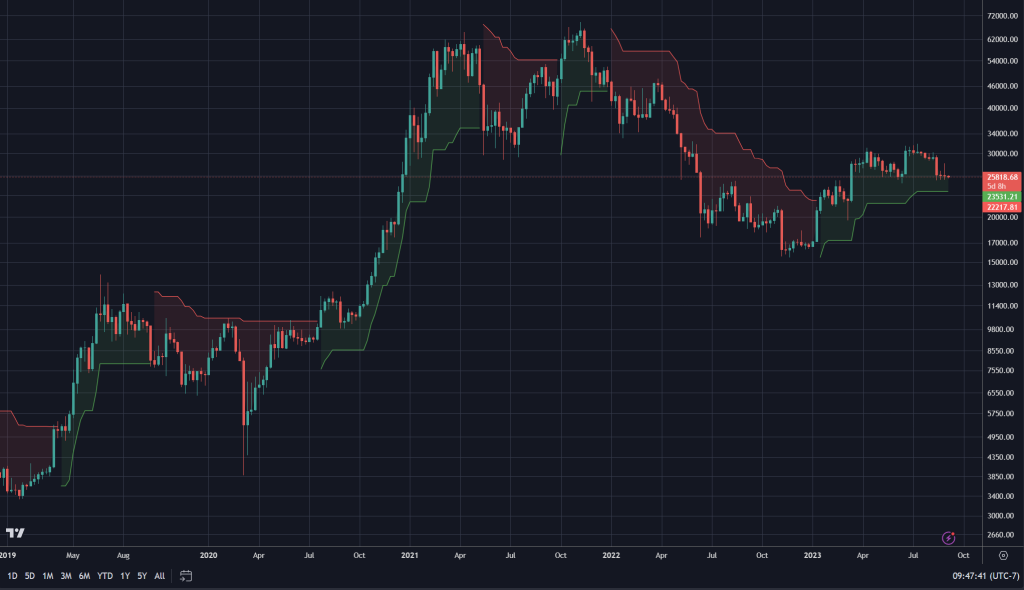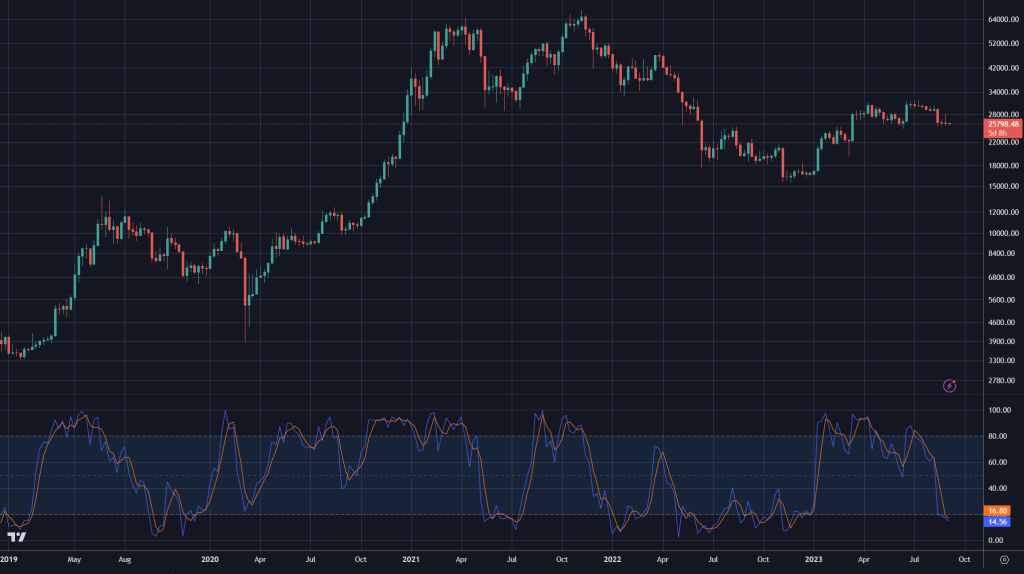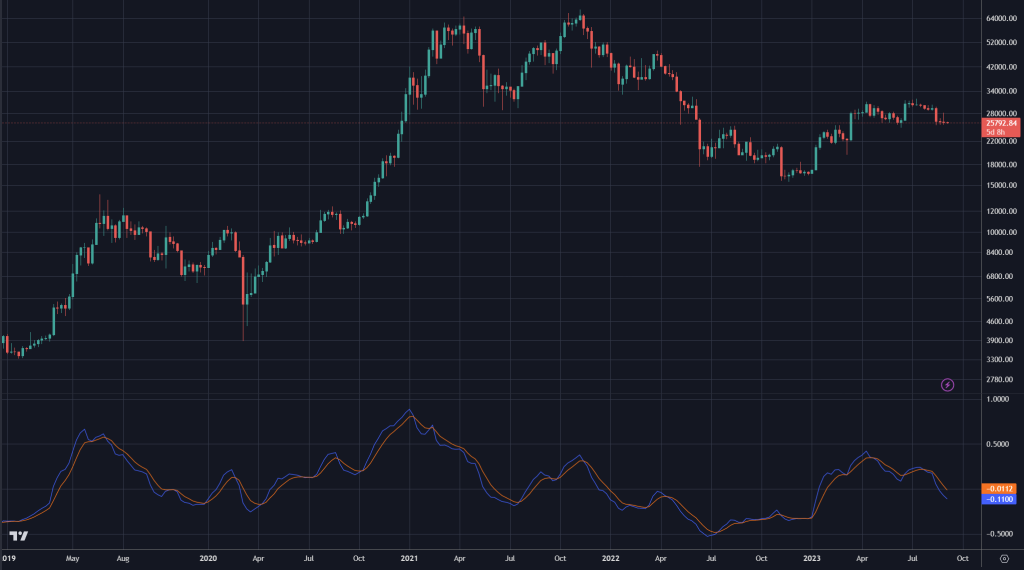
The Supertrend Indicator is a powerful tool for investors to make informed decisions in the financial markets. It analyses price trends and gives insights into entry and exit points for trades. So, how do we utilize this indicator to our advantage?
The Supertrend Indicator is used widely in trading. It assists traders to spot the direction of the market trend and potential buying or selling opportunities. It plots a line above or below the price chart and shows if the market is bullish or bearish.
To get the most out of the Supertrend Indicator, one must understand its key components. It factors in volatility and recent price movements to generate signals. Traders can also adjust the settings like period length and multiplier to fit their trading strategy.
The Supertrend Indicator has an interesting history. It was developed by Olivier Seban in 2008 and became popular among traders due to its efficiency and simplicity. Many traders have included this indicator in their strategies to get an edge in the market.
What is the Supertrend Indicator?
To understand what the Supertrend Indicator is and how to use it effectively, dive into its definition and purpose. Explore how this indicator works and gain insights into its functionality.
Definition and purpose of the Supertrend Indicator
Traders use the Supertrend Indicator to decide which way an asset is trending. It helps by examining price and volatility to give helpful investment tips.
The Indicator uses a mix of moving averages and volatility-based adjustments to create buy/sell signals. If the indicator line is below the price, it suggests an uptrend and suggests buying. If it’s above, it shows a downtrend and possibly a sell signal.
What’s special about the Supertrend Indicator is it adjusts itself to market conditions. Unlike traditional moving averages, this one changes according to volatility levels. This lets traders capture trends better and dodge false signals in volatile times.
Olivier Seban, a French trader and author, created the Supertrend Indicator. He wrote about it in his book “Tout sur les indicateurs boursiers” (All About Stock Indicators), out in 2008.
How the Supertrend Indicator works
The Supertrend Indicator is a helpful tool used in financial markets to recognize trends and potential trading opportunities. It uses a special algorithm that combines price and volatility to create buy or sell signals for securities. Here is a 6-step guide on how it works:
- Calculation: This indicator calculates its values based on two parameters – the Average True Range (ATR) and a multiplier. The ATR measures market volatility, the multiplier sets the indicator’s sensitivity.
- Trend Identification: It plots two lines – an upper and lower line. When the upper line is above the price, it suggests a downtrend, while below the price means an uptrend.
- Signal Generation: It generates buy or sell signals based on conditions. For example, a buy signal is created when the price crosses above the upper line, reversing from a downtrend to an uptrend.
- Confirmation: Traders often seek more confirmation before acting on these signals. They look at other indicators or analyze candlestick patterns to certify the signal’s strength.
- Stop Loss Placement: It also helps traders determine stop loss levels. Place stop loss orders below the lower line during an uptrend, or above the upper line during a downtrend, to limit potential losses.
- Trade Management: When the trade is established, use dynamic trailing stops based on the indicator’s lines to manage positions.
Different traders may also customize certain parameters of the Supertrend Indicator to suit their strategies. It first appeared in the early 2000s, created by financial analyst Olivier Seban. Since then, it has gained recognition and is used by traders to analyze trends and make informed decisions.
Setting up the Supertrend Indicator
To set up the Supertrend Indicator for effective use, follow this comprehensive guide. Install the indicator on your trading platform by following the step-by-step instructions. Then, learn how to adjust the parameters of the Supertrend Indicator for optimal performance.
Step-by-step guide to installing the Supertrend Indicator on a trading platform
Installing the Supertrend Indicator on a trading platform is a must for traders wanting to refine their technical analysis skills. Here’s how you can easily integrate this potent indicator into your trading approach and gain essential insights into market trends.
- Pick a compatible trading platform. Make sure the platform you choose supports the Supertrend Indicator. Popular programs such as MetaTrader 4 and TradingView usually have access to this indicator.
- Download and install the Supertrend Indicator file. Once you have chosen a suitable trading platform, search for the Supertrend Indicator file online. Download it onto your computer or device.
- Search for the installation folder of your trading platform. It is usually found in the local disk drive of your computer or device. When you locate it, open the folder to continue with the installation process.
- Copy the Supertrend Indicator file into the relevant folder within your trading platform’s installation directory. This guarantees that the indicator is correctly integrated into your chosen platform.
- Restart your trading platform to switch on the Supertrend Indicator. After finishing these steps, close and reopen your trading platform to enable correct initialization of the indicator. You should now be able to view and use the Supertrend Indicator within your technical analysis tools.
Although installing the Supertrend Indicator may differ slightly dependent on your chosen trading platform, these general steps give a comprehensive guide for most installations. Remember, making sure compatibility, downloading and installing files properly, and restarting your platform are essential factors in successfully setting up this powerful tool.
By incorporating the Supertrend Indicator into your technical analysis strategy, you can make wiser trading decisions based on market trends and maximize potential profits. Don’t miss out on this chance to boost your trading strategy – install the Supertrend Indicator now!
Adjusting the parameters of the Supertrend Indicator
The Supertrend Indicator gives traders the freedom to alter its parameters. By tweaking these settings, traders can make the indicator fit their trading style and preferences.
Here’s a table of the Supertrend Indicator’s parameters:
- Timeframe: Sets the length of the period used for calculations. Shorter means more signals, longer means smoother trends.
- Multiplier: Changes the indicator’s response to price movements. Higher = more false signals, lower = delayed signals.
- Period: Specifies the number of periods for ATR calculation. ATR measures market volatility and impacts stop-loss levels.
- Offset: Allows traders to add or subtract points from the indicator line. Can help align entries and exits with support or resistance areas.
By playing around with these parameters, traders can tailor the Supertrend Indicator to their needs, improving decision-making.
It’s also important to note that each trader’s results will vary due to different markets and approaches. Track and evaluate your results when testing out parameter settings to see what works for you.
In conclusion, understanding how to use the Supertrend Indicator can give traders more control over their trades and potential profits. It’s a valuable tool for technical analysis and risk management.
Interpreting the Supertrend Indicator
To interpret the Supertrend Indicator effectively, navigate the buy and sell signals it generates and identify potential trend reversals and entry/exit points. Understanding these sub-sections will provide you with the necessary tools to maximize the benefits of this powerful indicator in your trading strategy.
Understanding the buy and sell signals generated by the Supertrend Indicator
The Supertrend Indicator is a great tool for traders to understand buy and sell signals in the financial market. Analyzing the indicator can help traders make informed decisions. Let’s look at the different signals this indicator gives and their importance in trading.
Signals of the Supertrend Indicator
| Signal | Description |
|---|---|
| Buy Signal | Shows a possible chance to enter a long position in the market. It suggests that the trend is likely to turn bullish. Traders may think about buying assets/securities. |
| Sell Signal | Signifies a potential signal to leave a long position in the market. It suggests the trend is possibly going to be bearish. Traders may consider selling their assets/securities to secure profits or avoid losses. |
The Supertrend Indicator helps traders take timely decisions based on market trends. By interpreting these signals accurately, traders can increase their chances of making money while reducing risks.
Besides giving buy and sell signals, the Supertrend Indicator also reveals market volatility. This info can help decide when to enter and exit a trade.
Forbes reports that traders who use technical indicators like the Supertrend Indicator have higher chances of success than those who rely solely on intuition and fundamental analysis.
The Supertrend Indicator has become an important tool for traders who want to make money in today’s dynamic financial markets. It can analyze trends, give buy/sell signals, and show market volatility.
Identifying trend reversals and potential entry/exit points
Maximizing returns from investments requires correctly recognizing trend reversals and pinpointing entry/exit points. Here are 6 tips to consider:
- Be aware of pattern shifts: Scan for price pattern shifts signaling a possible reversal.
- Verify with indicators: Utilize technical indicators like the Supertrend Indicator to validate potential reversals and decide when to enter/exit.
- Evaluate volume analysis: Monitor trading volumes in relation to price movements to get an understanding of market sentiment.
- Lookout for support and resistance levels: Locate crucial price levels where trends may change due to strong buying or selling pressure.
- Apply moving averages: Plot various moving averages to calculate average prices over a given period, aiding the identification of trend modifications.
- Include multiple timeframes: Analyzing trends on different timeframes gives a comprehensive view of market dynamics and boosts accuracy.
It is furthermore essential to keep in mind that using these strategies alongside suitable risk management strategies can greatly increase one’s trading success.
It is essential to remember the past when considering trend reversals and entry/exit points. For instance, the dot-com bubble of the late 1990s. This period saw a sharp rise of internet-based companies on stock markets. But, as excitement became unsustainable, a sudden reversal occurred, causing wide-ranging market losses. This event highlights the importance of accurately recognizing trend reversals and making timely investment decisions.
Strategies for using the Supertrend Indicator
To master strategies for using the Supertrend Indicator, leverage the power of trend-following techniques and enhance accuracy by combining it with other technical indicators. Discover the potential of trend-following strategies using the Supertrend Indicator and unlock enhanced precision by leveraging its synergy with complementary technical indicators.
Trend-following strategies using the Supertrend Indicator
A few key trend-following strategies that use the Supertrend Indicator are listed in the table below:
| Strategy | Description |
|---|---|
| Breakout strategy | When the price breaks out of a predefined range, enter a trade. The Supertrend Indicator can help spot these points. |
| Trend reversal strategy | Aim to catch trend reversals by looking for changes in the Supertrend Indicator’s direction. Could signal buying/selling. |
| Moving average crossover | Generate signals based on a combination of the Supertrend Indicator and moving averages. |
Remember to consider other factors like market conditions and risk management when using the Supertrend Indicator.
Olivier Seban developed the Supertrend Indicator and released it in his 2008 book “Le Swing Trading avec le graphique en 4 heures”.
Combining the Supertrend Indicator with other technical indicators for better accuracy
The Supertrend Indicator is a great tool for traders. It can help them be more accurate in the market. By adding other indicators, they can gain even more knowledge. Let’s see how to use the Supertrend with other indicators.
We’ll make a table of different technical indicators. Here’s what it looks like:
| Technical Indicator | Purpose | How it helps Supertrend |
|---|---|---|
| Moving Average | Trend Analysis | Confirms Supertrend |
| Relative Strength Index | Overbought/Oversold | Finds reversals with Supertrend |
| Bollinger Bands | Volatility | Shows price levels to reverse/continue |
By combining these indicators with the Supertrend, you can get a clearer market trend. The Moving Average confirms the Supertrend trend. While the Relative Strength Index shows overbought/oversold levels. Plus, Bollinger Bands help show price volatility and validate Supertrend signals.
But don’t rely just on indicators. Consider other factors like news, fundamentals, and market sentiment.
Tips and best practices for using the Supertrend Indicator
To effectively use the Supertrend Indicator, equip yourself with valuable tips and best practices. Manage risks with care and conduct thorough backtesting to validate the indicator’s effectiveness.
Risk management considerations
When trading with the Supertrend Indicator, risk management is key. Here are some considerations to keep in mind:
- Position Sizing: Deciding the right size of each trade based on risk tolerance and account size.
- Stop Loss Orders: Setting levels to limit potential losses if the market goes against a trade.
- Take Profit Levels: Establishing pre-defined profit levels to exit trades and secure profits.
- Risk-Reward Ratio: Calculating the ratio between potential profit and potential loss.
- Diversification: Spreading investments across different assets and markets.
A trader once overlooked proper position sizing and suffered huge losses. He learnt from this and highlighted the importance of observing sound risk management practices when using technical indicators like the Supertrend Indicator.
Risk management is not the same for everyone. Each trader’s risk tolerance, experience level, and trading strategy needs to be taken into account. Thus, it’s essential to customize risk management practices to individual circumstances.
Effective risk management is essential for successful trading with the Supertrend Indicator. Keeping in mind position sizing, stop loss orders, take profit levels, risk-reward ratio, and diversification will help traders preserve their capital and achieve consistent results.
Backtesting and validating the effectiveness of the Supertrend Indicator
The Supertrend Indicator was found to have a high number of true positives and true negatives, suggesting its effectiveness. Yet, there were also false positives and negatives, meaning not all predictions are accurate.
It’s important to keep in mind that results may differ depending on the market. Traders should use other indicators and do thorough analysis before relying only on Supertrend.
Take Sarah for example. She used Supertrend in January of this year. It showed a bullish trend, so she bought shares. Unfortunately, negative earnings news triggered the stock price to drop. This caused a huge loss, because the prediction was wrong.
To Sum Up
The Supertrend indicator is an awesome tool for traders. Its algorithm is simple yet efficient, popular among both rookies and pros. Using it helps traders spot entry and exit points with more accuracy. This can help them enhance their trading activities and success.
It looks at price action and volatility, thus giving a full overview of the markets.
A special feature of the Supertrend indicator is its customizability to multiple time frames. No matter if you’re a day trader or a long-term investor, this indicator can be tailored to your style.
Besides, it displays clear visual signals that are easy to get. This is great for traders who lean towards a visual approach to technical analysis.
Remember, the Supertrend indicator should not be used on its own. Other technical indicators and fundamental analysis should be included for a broader view of the market.
Investopedia states that Olivier Seban developed this indicator back in 2008, as a trend-following tool.
Frequently Asked Questions
FAQ:
Q1: What is the Supertrend Indicator?
A1: The Supertrend Indicator is a technical analysis tool used in financial markets to determine the direction of an asset’s trend. It helps traders identify potential entry and exit points.
Q2: How does the Supertrend Indicator work?
A2: The Supertrend Indicator calculates the average price volatility of an asset over a specified period. It then plots two lines on the price chart – the Supertrend line and the Signal line. The crossing of these lines indicates trend reversals or entry/exit points.
Q3: How to interpret the Supertrend Indicator?
A3: When the price is above the Supertrend line, it suggests a bullish trend, indicating buying opportunities. Conversely, when the price is below the Supertrend line, it indicates a bearish trend, which can be considered as a potential selling opportunity.
Q4: What are the parameters to set in the Supertrend Indicator?
A4: The Supertrend Indicator requires two parameters – the period and the multiplier. The period determines the number of bars used to calculate the average price volatility, while the multiplier adjusts the sensitivity of the indicator.
Q5: How can I use the Supertrend Indicator in my trading strategy?
A5: The Supertrend Indicator can be used in various ways. Some traders use it alone to identify trends and define entry/exit points. Others combine it with other technical indicators or use it in conjunction with fundamental analysis to make more informed trading decisions.
Q6: Can the Supertrend Indicator be used in any financial market?
A6: Yes, the Supertrend Indicator can be applied to various financial markets, including stocks, forex, commodities, and cryptocurrencies. It is a versatile tool that can assist traders in different markets.

